Stargazing

|
Hydra the Sea Serpent |

|
- Just below the barely discernable figure of Cancer the Crab is a fairly distinct
grouping of about six stars. You are looking at the two eyes, the two nostrils,
and the two stars that begin the neck of the longest and largest constellation
in the entire sky, Hydra the Sea Serpent. {Trace out the entire length of
Hydra}
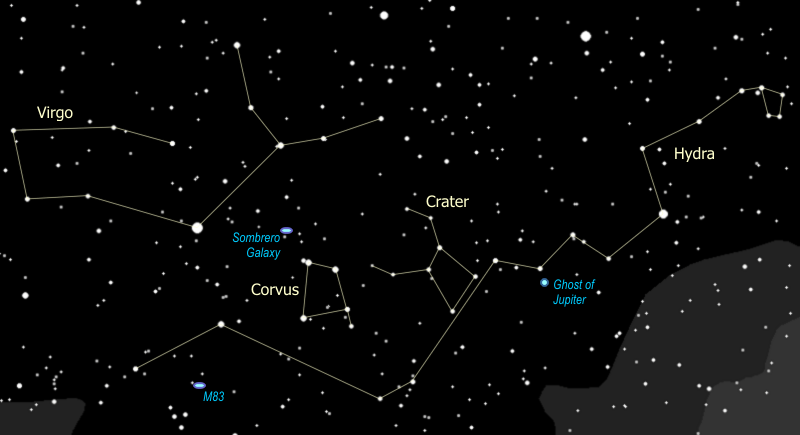
- Now if you look halfway between Hydra's head and the star Procyon and go south
to form an equilateral triangle with those two, you see a small triangle of
stars at that spot. Put the binoculars on that triangle and at its center you
will find the Lost Star Cluster, M48. Charles Messier put this group on his
list in 1771, and no one found it again for almost 200 years, because he wrote
the location down wrong -- off by 4°.
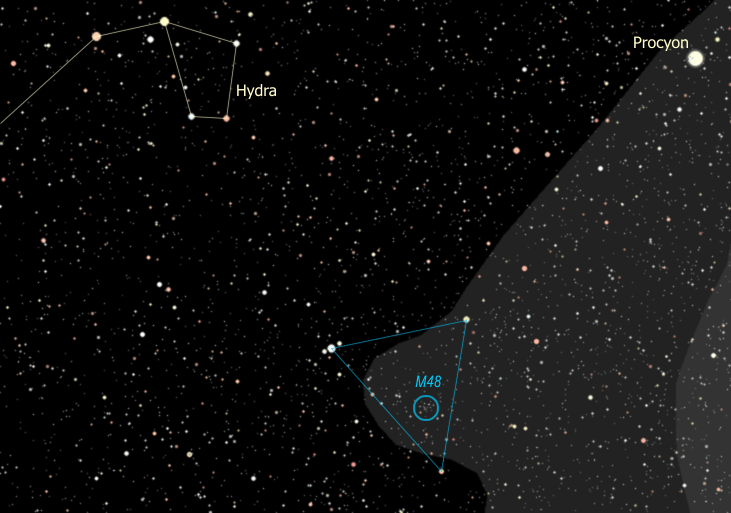
- We now go from the head of the sea serpent and follow the undulating back, to
the bright star that is the heart of the serpent, "Cor Hyrae". This star is
more commonly known as "Alphard", The Solitary One, because it stands as the
lone bright star in this otherwise empty part of the sky. So what do you think,
is Alphard the brightest star in the sky right now? Do you see any stars you
think might be even brighter? Certainly Procyon is brighter. Which do you
think is brighter, Alphard or Pollux? How about Pollux and Capella, which do
you think is brighter?
Astronomers measure star brightness using 'magnitudes' -- Capella has a magnitude of 0, Pollux has a magnitude of 1, Alphard has a magnitude of 2. As magnitude number goes up, brightness goes down. A magnitude 1 is 2½ times as bright as a magnitude 2, a 2 is 2½ times as bright as a 3, and so on.
This comes from the system set up by ancient Greeks, where the brightest stars were stars of the first magnitude, like 'first class', and the faintest stars you could see were stars of the sixth magnitude. When astronomers got telescopes and instruments that could measure star brightness, they found 1st magnitude stars were almost exactly 100 times the brightness of 6th magnitude stars. That works out to a factor of 2½ from one magnitude to the next.
Magnitudes can go negative for stars brighter than 0 magnitude Capella. Sirius, the brilliant winter star that is now setting on the western horizon, is the brightest star anywhere in the sky (any time of the year) with a magnitude -1.5.
Well, what's really the brightest star in the sky? The sun has a magnitude of -27.
- It's not only the brightness of each star that is different. Look at
Castor and Pollux. Can you see a difference in color between these
two stars? Castor is white, and Pollux is more yellow or even orange.
Now let's look at those two stars down by the feet of Castor (the twin).
{Point out ν (nu) and μ
(mu) Geminorum}. It is probably easier to compare them using the
binoculars. How would you describe the color difference of those two?
One of them is very red, and the other is... blue, isn't it? What color
would you call Alphard? Pretty red, isn't it? So what do the star
colors mean? Why would one star be blue and another red?
Yup, that's right. Different colors show different temperatures. So which star color is the hottest? Just like a flame, blue is the hottest part, yellow is next, red is the coolest. The sun is a yellow star, about 10,000°F at the surface. A red star is about half the sun's surface temperature, whereas a blue star is three to five times as hot as the sun. White stars like Sirius are somewhere between the yellow ones and blue ones.
Now, all stars are made of pretty much the same stuff -- about 90% hydrogen and the rest is helium with some traces of other stuff. So, why would one star be burning hotter than another? The answer is in the size of the star. The more massive it is, the more pressure there is at the center and therefore the hotter - and for that matter the brighter - the star burns. So blue stars are the biggest and brightest of stars, and red stars are the smallest and dimmest.
So why is red Alphard so bright? Hmmm... yeah... well, like with most rules, there are exceptions to the rule, and this rule is no exception. Alphard is a star that is literally running out of gas. As a star burns up all the hydrogen at its center, it starts to burn helium (which is the "ash" from the hydrogen burning), which makes it expand, get brighter, and turn red -- it becomes a red giant. This is the time you can get a bright red star, when the star is near the end of its life.
When our sun starts burning out it will expand so big it will swallow up Mercury and Venus and scorch the surface of the earth to a cinder. If you are hoping to see all that happen you will have to wait about 5 billion years.
So there are two reasons a star could be red -- it is massive (and once was yellow, white or even blue) and is now burning out (a red giant), or it never had enough mass to burn any hotter than red (a red dwarf).
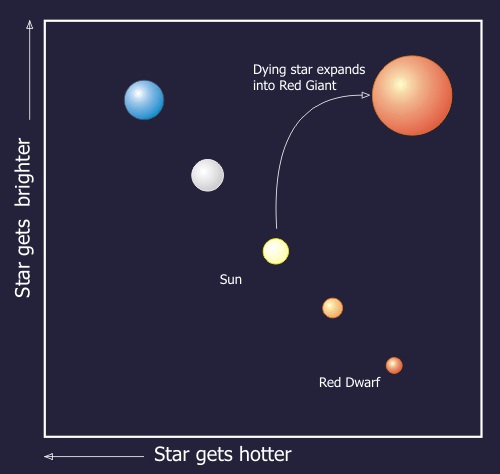
Notice that when we graph out the stars showing their temperature (or color) against their brightness, most of them fall along a line -- this line is called the Main Sequence, and the graph is called the "H-R" (for Hertzsprung-Russell) Diagram. Others are not on the main sequence, mostly stars that are either just being born (called "T-Tauri" stars) or stars that are near the end of life.
- Let's continue on along the back of the sea serpent, through the dip of
the first coil and we will stop at the bottom of the second coil. We are
going to direct our telescope right there, looking for the Ghost of Jupiter.
This is another planetary nebula -- a "wreath around a dying star", like the
Eskimo Nebula. Look carefully and you can see the central star that is
powering the lights on this glowing disk.
Ghost of Jupiter in Telescope What you're looking at 
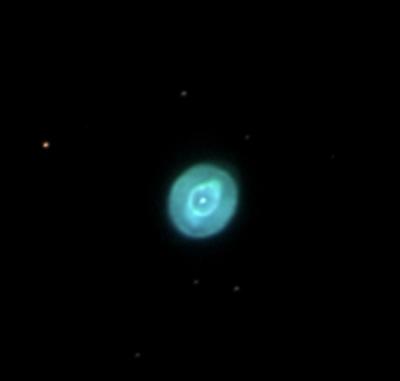
- As we continue down the sea serpent's back we come
across two other constellations - literally riding the back of Hydra.
The first one is called "Crater", it's supposed to be a cup and you
can actually see it, although admittedly it looks like it's been
dropped more than once. {Trace out Crater the Cup}
- Following right behind Crater is that much brighter,
odd-shaped square, or kind of a trapezoid. This is the constellation
"Corvus" and it's supposed to be a Crow. Don't see a crow? Try this
- the two top stars of the trapezoid are each a wing tip (he's holding
them up), his body is the line of stars across the bottom, and his head
is the star below the trapezoid on the right. Still don't see a crow?
Nah - neither do I.

So why is it a crow if it doesn't look like one? Well, it fits with an ancient fable wherein Apollo gives a crow his cup and sends him for water (he's a god - he can send a bird to get water for him... in a cup... and somehow it's supposed to work out). Well the crow stopped to eat some figs -- well, actually, he waited for them to ripen first -- so he came back really late. He tried to get out of it by telling Apollo that a serpent held him up, but Apollo wasn't fooled, so he placed the crow and the cup in the sky along with the serpent, with instructions to the snake to keep the cup just out of the crow's reach.
- Ok. So maybe we can't see a crow, but we can see a galaxy - two if we are
lucky, and these are very cool-looking ones. I'm setting up the telescope
to look at the Sombrero galaxy, on the southern edge of the band of galaxies
that stretches across the center of the spring sky. The disk of this galaxy
is very clearly defined and rimmed with a dark ring of dust. It is nearly
edge-on to us, and tilted slightly so that the dome of the galaxy core is
clearly visible. All this gives the galaxy the look of a Mexican hat --
hence the name. You are looking across 40 million light years of space
(and 40 million years back in time) when you see this galaxy, a member of
the Virgo cluster of galaxies that we will discuss momentarily.
- If we have the time, the conditions, the equipment (a pretty good telescope),
and the inclination we will continue on a galactic pursuit by moving the
scope down to M83 -- just south of the end of Hydra's tail. While the
Sombrero is an edge-on galaxy, this one is an exquisitely beautiful face-on
spiral. Seeing the graceful spiral arms of this galaxy, though, requires
a telescope of about 12" diameter. On those rare occasions that you have
such a scope (or bigger) on hand, and a dark, clear night, this is what
to do with it. M83 is about 10 million light years away and is known
among astronomers for producing supernovae - about one every 10 or 15 years,
where most galaxies get one per 300 years.
The Sombrero Galaxy from the Hubble Telescope The magnificent spiral galaxy M83 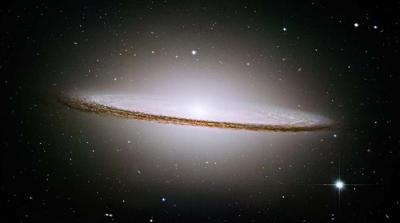
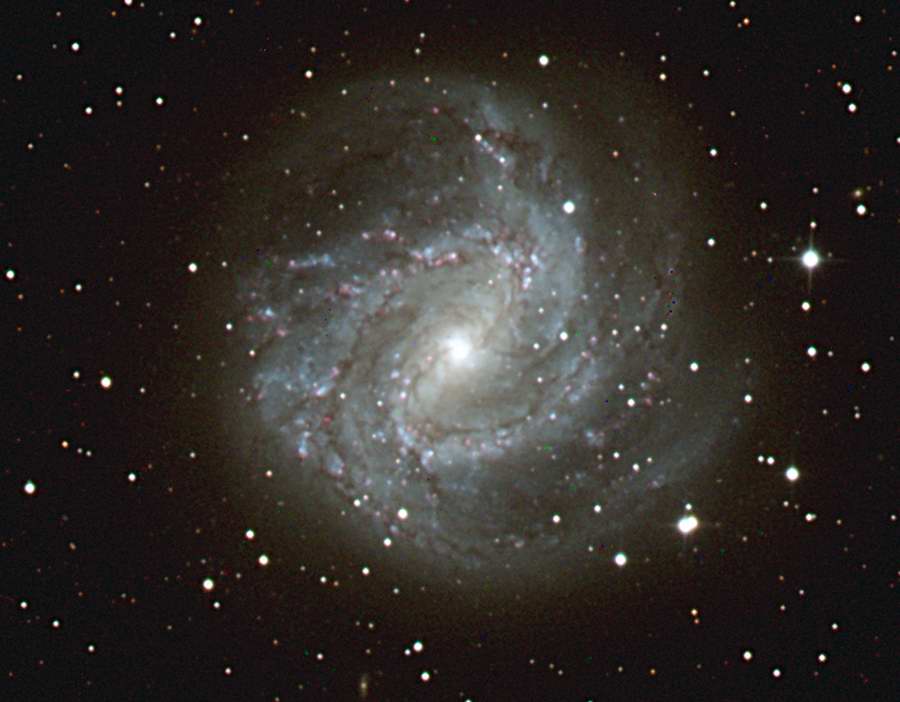
 |
 |
 |
| Back to Gemini | Go to Spring Index | On to Virgo |
Questions
Your questions and comments regarding the Stargazing section are welcome.
You can e-mail the author, Randy Culp for inquiries,
suggestions, new ideas or just to chat.
Updated 18 July 2023
